The Right Leopard
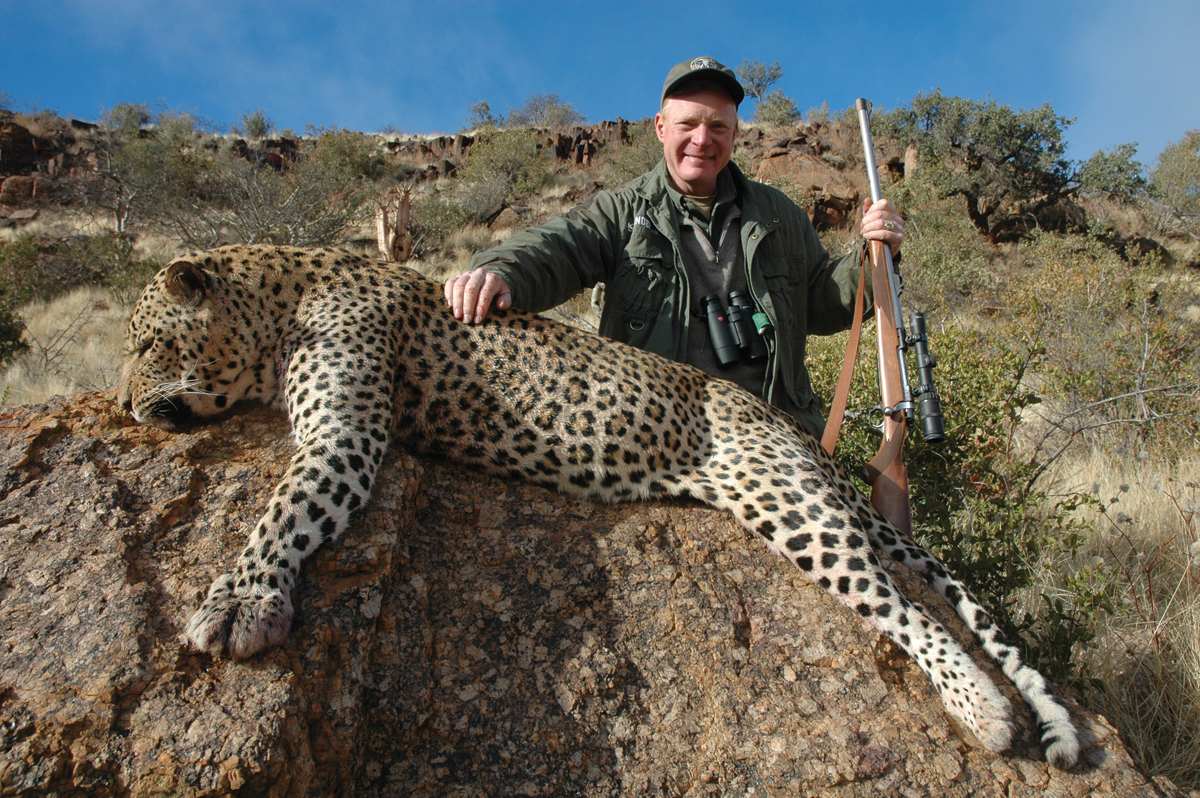 Hunting “Old Spots” has changed!
Hunting “Old Spots” has changed!
It is impossible to properly count wild leopards, but estimates range from a low of nearly 700,000 to as high as two million. Either way, there are a lot of leopards. The sport-hunted harvest is not significant and clearly sustainable, and I believe there are a lot more leopards today than when I started hunting in Africa. Certainly this is absolutely true in Namibia and South Africa! With more leopards, I also believe leopard hunting is better than it used to be—but it has changed quite a bit.
When “A Leopard Was A Leopard”
Perhaps the biggest change in leopard hunting over the years is that we now specifically target male leopards. That was not the case just 25 years ago! Oh, sure, a big male leopard has always been more desirable, but when I started hunting Africa there was very little stigma about taking a mature female.
These days, ethical professional hunters try hard to specifically hunt and only take male leopards. Like all cats, leopards are actually fairly prolific, but since today most outfitters have finite concessions that they hunt year after year, they know taking a female leopard will 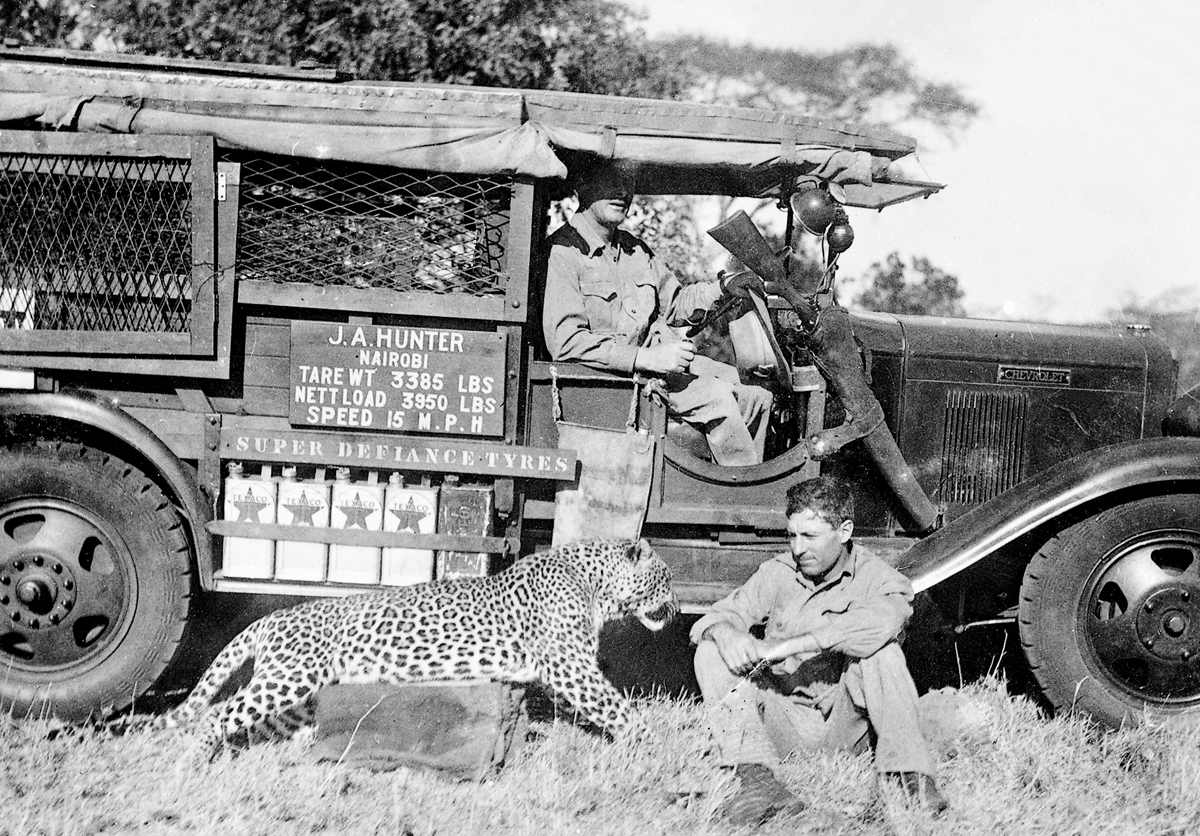 come back to bite them down the road. The ethic to take only male leopards is strong enough today that in several countries it is reinforced by game laws. In Zimbabwe, for instance, the license now specifically states ‚Äúmale leopard.‚Äù A PH who makes a mistake pays a stiff fine to Zimbabwe Parks and Wildlife…and if the error is repeated, his professional hunter license is in jeopardy. In both Namibia and Tanzania there are ‚Äúminimum standards,‚Äù so while female leopards aren‚Äôt specifically illegal it takes a really big tabby to qualify!
come back to bite them down the road. The ethic to take only male leopards is strong enough today that in several countries it is reinforced by game laws. In Zimbabwe, for instance, the license now specifically states ‚Äúmale leopard.‚Äù A PH who makes a mistake pays a stiff fine to Zimbabwe Parks and Wildlife…and if the error is repeated, his professional hunter license is in jeopardy. In both Namibia and Tanzania there are ‚Äúminimum standards,‚Äù so while female leopards aren‚Äôt specifically illegal it takes a really big tabby to qualify!
In Zimbabwe, before changing the law to “male leopards only,” they took a close look at harvest records, most female leopards reported were taken in the last few days of a safari. This suggests that females were more likely to be taken when the pressure was on, chips were down, and time was running out. Now the pressure is constant: Zimbabwe PHs must be absolutely certain they’re looking at a male leopard before giving the go-ahead.
Nowhere in Africa is leopard hunting absolutely 100 percent successful. Leopard hunting is difficult and time-consuming, and there are many variables. The requirement to take a male leopard makes it more difficult—but today we are long past the concept that “a leopard is a leopard.” The idea is to take a male leopard, and even then my belief is that leopard hunting today is generally more successful than it was in the 1980s. In part this is because there are more leopards, but in specific hunting areas local leopard populations are probably healthier because the harvest is primarily males.
Hunting Methods
Research I’ve done suggests that baiting for leopards was uncommon until after World War II. Before 1940, safaris tended to be longer and there were probably more leopards, certainly more than in the 1970s and 1980s. In the course of a normal safari, a leopard would probably be encountered sooner or later…and a leopard was a leopard. By the 1950s, safaris were getting shorter and professional hunters had to figure out how to specifically hunt leopards. Baiting became the standard option and remains so today. 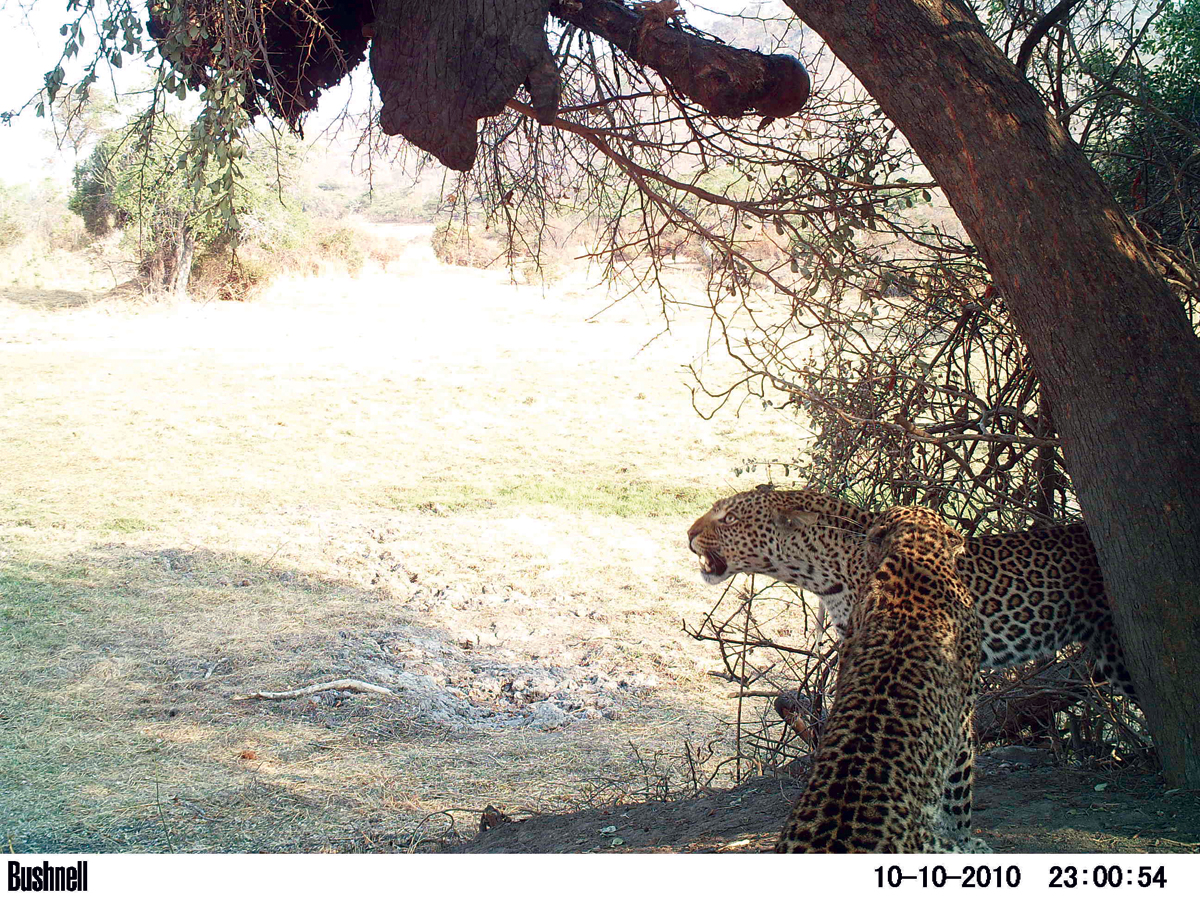 It wasn’t until after World War II that telescopic sights came into common use, and since leopards on bait are usually taken in poor light, my theory is the riflescope was the great enabler for hunting leopard over bait.
It wasn’t until after World War II that telescopic sights came into common use, and since leopards on bait are usually taken in poor light, my theory is the riflescope was the great enabler for hunting leopard over bait.
Today, baiting is the most widespread option, but other ways to skin the cat include tracking, running with hounds, calling and the good old chance encounter. We will quickly dispense with these last two. In 1985, baiting was not legal in Botswana, so we hunted leopard with a varmint call. It worked, but all we knew was that we were looking at an adult leopard. It would not have been possible to determine the sex…but in those days this wasn’t considered necessary. Pretty much the same applies to a chance encounter. It is very unusual to just see a leopard in the bush, have time to study it long enough to be fairly certain of sex and size, and then have a chance for a shot.
Today’s hunting techniques need to be both effective and selective. To my knowledge that leaves tracking, hunting with hounds, and 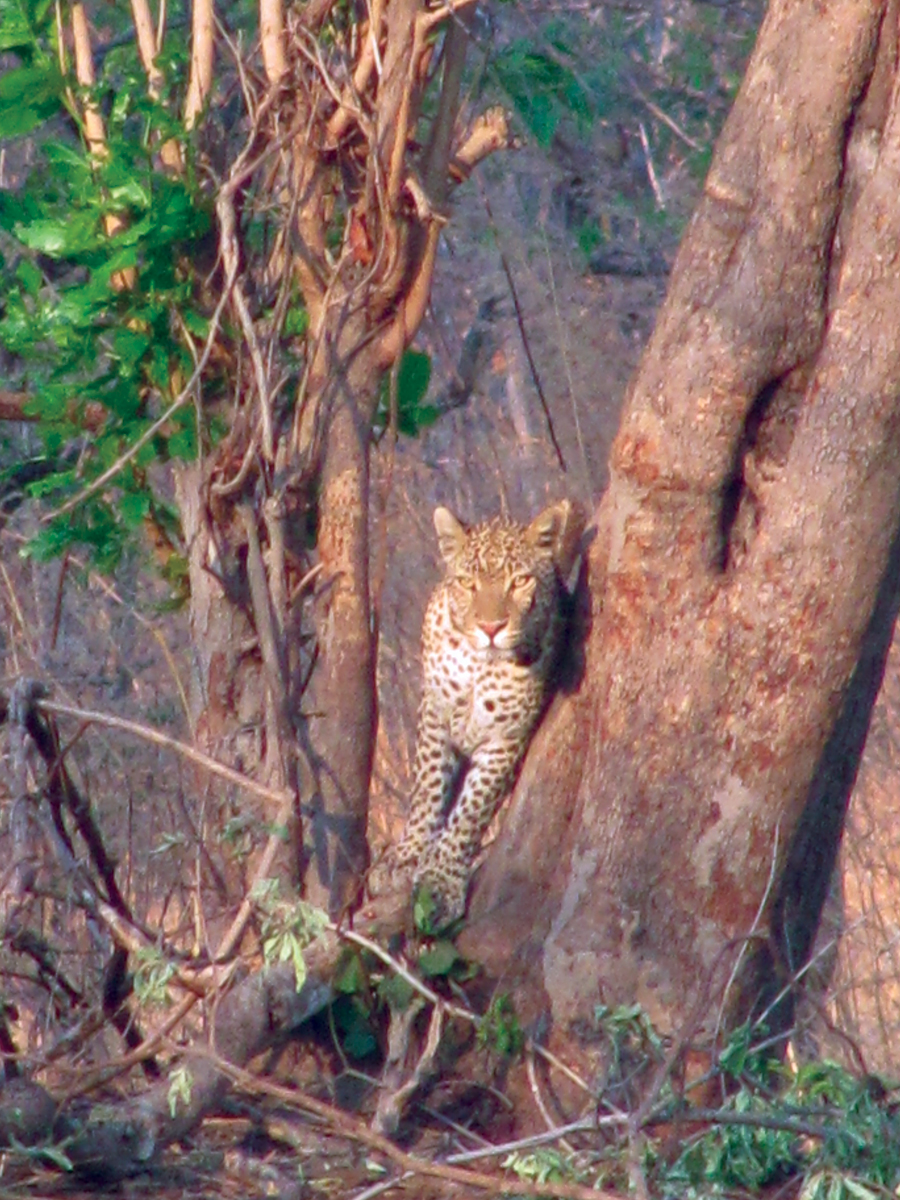 baiting. Tracking is selective because you can absolutely determine the approximate size of a leopard from its tracks. The problem is there are very few areas where soil conditions make it possible to actually track an animal as light-footed as a leopard. This was the method of choice in Botswana’s Kalahari, where the sandy soil offered perfect tracking conditions.
baiting. Tracking is selective because you can absolutely determine the approximate size of a leopard from its tracks. The problem is there are very few areas where soil conditions make it possible to actually track an animal as light-footed as a leopard. This was the method of choice in Botswana’s Kalahari, where the sandy soil offered perfect tracking conditions.
Evaluating tracks, however, remains a critical element in both baiting and hunting with hounds. Again, tracks don’t lie when it comes to size. They do not exactly tell sex, but a really large track is surely a big tom. This requires some local knowledge. For instance, leopards tend to be bigger in Zimbabwe’s Lowveld than in the Valley; and in Tanzania, bigger in Masailand than in the Selous. In any area there will be some overlap between the track of a mature female and a young tom, but the track of a big male is unmistakable. Typically you try to measure a clear track of a front foot, heel to toe. In the Zambezi Valley an 8.5-centimeter track is probably a male…but could be a big female. A 9-centimeter track is for sure a nice tom, and it’s highly unusual in that area to see a track bigger than 9.5 centimeters. In areas where leopards are known to grow very large you have to increase the scale a bit.
Evaluating tracks is critical to any discussion of hunting leopards with hounds. Unlike mountain lions, which are often hunted by simply looking for tracks, leopard chases are usually started from bait. The bait is simply hung with no intent to build a blind—but full intent to capture tracks. Hound hunting for leopard is fast, furious and often dangerous…but its detractors often claim that it is not 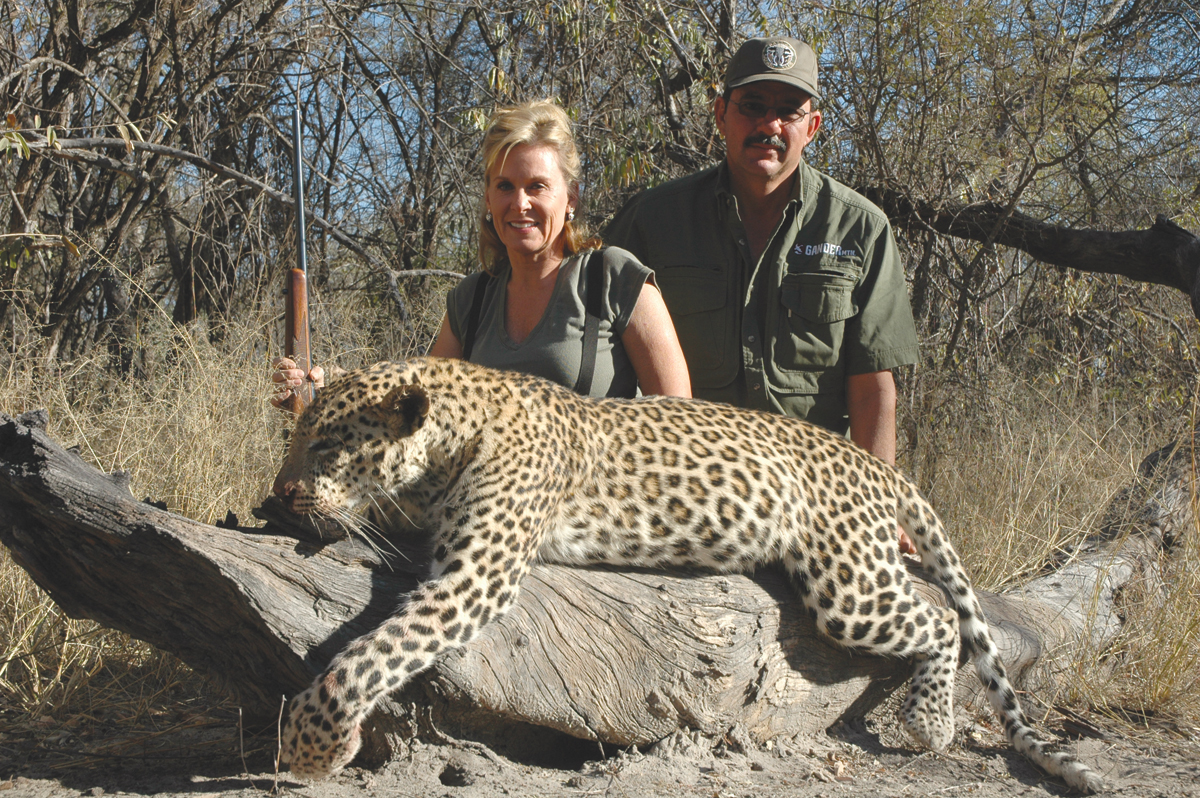 selective. That is simply not true. There is no reason to release the dogs on anything but the track of a big male. It is not impossible for the dogs to get onto the wrong leopard. They are following scent, not size, so if the big track crosses a fresher track they will surely take it. But it is also not true that a leopard bayed or treed must be taken. A well-trained pack can usually be called off. So, in hound hunting, you have two chances to walk away: First, when you see the track and, second, when you see the leopard.
selective. That is simply not true. There is no reason to release the dogs on anything but the track of a big male. It is not impossible for the dogs to get onto the wrong leopard. They are following scent, not size, so if the big track crosses a fresher track they will surely take it. But it is also not true that a leopard bayed or treed must be taken. A well-trained pack can usually be called off. So, in hound hunting, you have two chances to walk away: First, when you see the track and, second, when you see the leopard.
It is also not true that success with hound hunting is foolproof. Maybe you never find a fresh track big enough to follow—and even if you do, there are lots of ways a leopard can outdistance or outmaneuver a pack. It is, however, a very successful technique. To my thinking, hound hunting is a fine option in ranch country. “Ranch” leopards are inveterate cattle killers. As such, they have been persecuted for a century and it is almost impossible to get them on bait in daylight. Shooting at night is perfectly legal in some areas, questionable in others, and absolutely illegal in some jurisdictions…but, whether in moonlight or with artificial light, the shot is more difficult at night and it is also more difficult to determine sex and size. Hound hunting is thus a viable option…and it’s a wonderfully exciting way to hunt leopard.
Baiting is the most common tactic. Over the years the techniques have been highly refined—but all experienced PHs have their own tricks. Setting bait for a daylight shot is quite a bit different than in areas where night shooting is legal. Getting a leopard to come in daylight complicates things because you’re asking a nocturnal hunter to come to dinner not just at the place of your choosing, but also the time.
Generally speaking, daylight baiting is most likely to be successful in 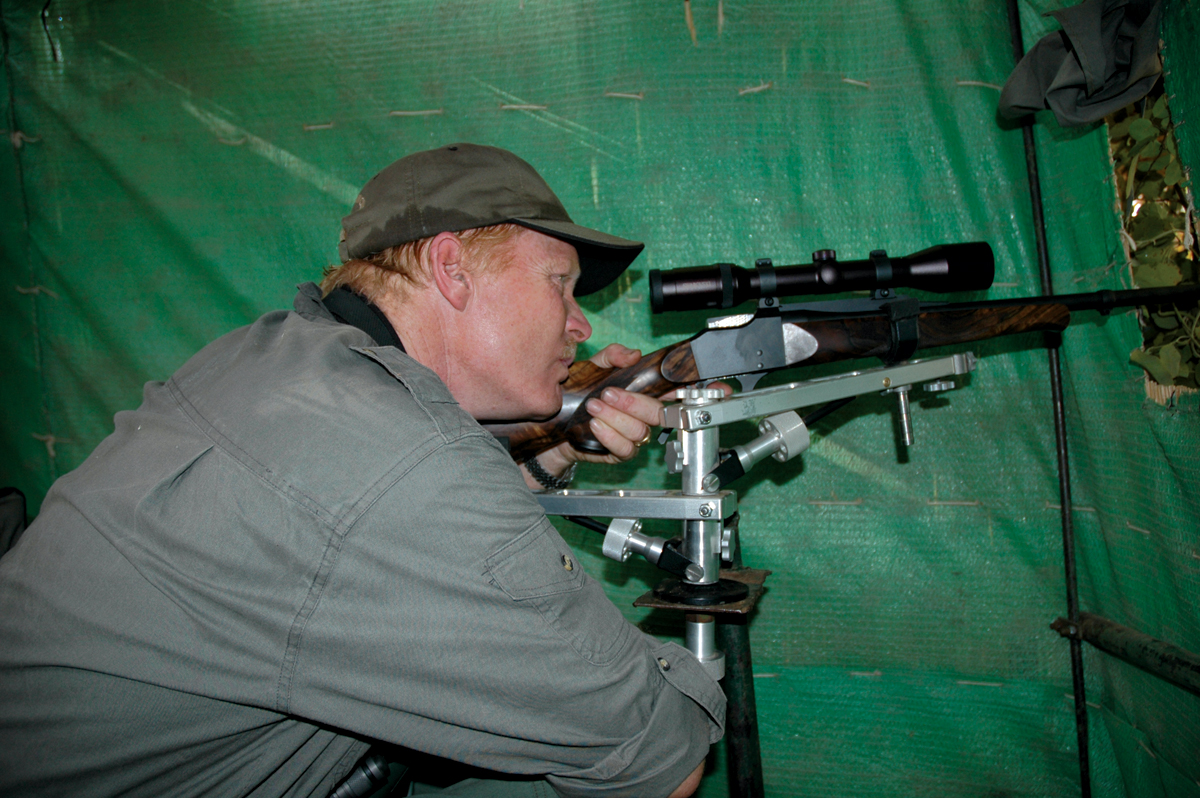 wild, remote country—but even there some leopards will be nocturnal feeders. So use trail cameras and timers, and keep other baits going (and options open) until your cat is in the salt! Ideally you want to put daylight bait in really thick country, with lots of brush near the tree so the cat will feel secure enough to come in. The blind site must be selected with care, and with an eye to concealed approaches. We all dream of the leopard coming onto the bait at last light—but a surprising number of leopards are morning feeders, so you may need to approach the blind in pre-dawn blackness while the leopard is in the tree. Baiting for night shooting can be simpler, but it can be an awfully long, cold wait and, as I said, the shot is more difficult.
wild, remote country—but even there some leopards will be nocturnal feeders. So use trail cameras and timers, and keep other baits going (and options open) until your cat is in the salt! Ideally you want to put daylight bait in really thick country, with lots of brush near the tree so the cat will feel secure enough to come in. The blind site must be selected with care, and with an eye to concealed approaches. We all dream of the leopard coming onto the bait at last light—but a surprising number of leopards are morning feeders, so you may need to approach the blind in pre-dawn blackness while the leopard is in the tree. Baiting for night shooting can be simpler, but it can be an awfully long, cold wait and, as I said, the shot is more difficult.
Either way, hunting days are limited, so your PH will do everything possible to “pre-qualify” the leopard before you sit for him. Tracks are thus extremely important. Typically the area around the base of the tree is swept; so clear tracks can be evaluated. The way the cat feeds is also important. Not just how much, but how. A big cat will smash the bait, demolishing bones; a young male or female will feed less, but also with less greedy abandon. Trail cameras are obviously wonderful tools. The idea is to never sit until you’re sure you have a shootable male feeding. Even then it’s touchy, because a breeding pair will feed on the same bait, and two altogether different leopards can come in from different directions, so the PH must take the time to be sure. Size and build are indicators, especially if it’s a really big tom, but with average, normal-sized adult leopards, sometimes the only way to be certain is to get the side angle and see the evidence protruding under the base of the tail.
Two things about leopard hunting give professional hunters gray hair: First, those interminable moments from the appearance of the cat until he is absolutely sure and can utter the sacred words, “Take him!” Second, when the cat exits the tree under its own power, and he doesn’t yet know what he might be facing! Never forget: The leopard is not a big animal, but among Africa’s Big Five it is the most likely to hurt you! Figure the stitches at double digit per second, and make your shot count
The Right Leopard
The right leopard is, simply, an adult male. Aging all animals is difficult, but unlike the lion and all horned and antlered game, with a leopard it is impossible. Some leopards are bigger than others, but any adult male is a sound and worthy trophy–period. Leopard hunting is difficult and is never 100 percent successful, so I think this is a hunt such that it is very unwise to attach pre-conceived notions and criteria regarding trophy dimensions. Set your sights on a nice male‚Äîand count your blessings if you get him. If you want a big leopard, then you should hunt in areas that typically produce very large cats, and tell your PH that you only want to sit on an outsized tom.
Realistically, this means your chances have gone down considerably! This is not a course of action I recommend for a first leopard. But if you like the chess game that is leopard hunting and want to try it again, then you have the luxury of being a bit pickier…provided you‚Äôre prepared for disappointment. In remote country in southwest Namibia in September 2013 we had two really big toms hitting widely separate baits‚Ķbut they‚Äôd hit, feed well, then vanish for several days. We went back and forth, tried everything, and still got beat. The downside of leopard hunting is I actually hate to sit still‚Äîbut I really enjoy the complex process of baiting, checking spoor, changing things up, and trying to figure out exactly why that doggone leopard won‚Äôt come in where and when you want him to. The answer, of course, is that only the leopard knows‚Ķand he isn‚Äôt telling.– Craig Boddington

